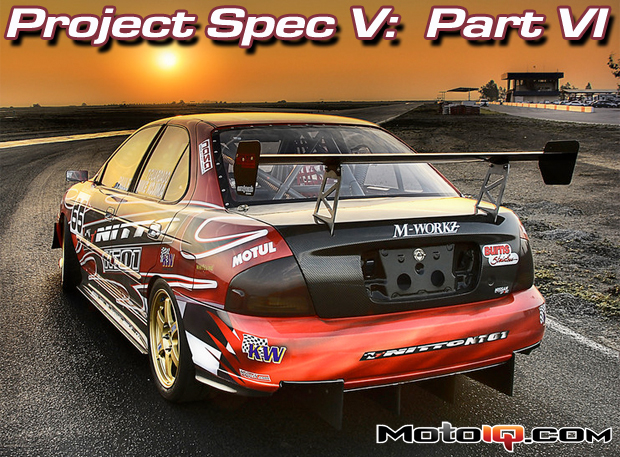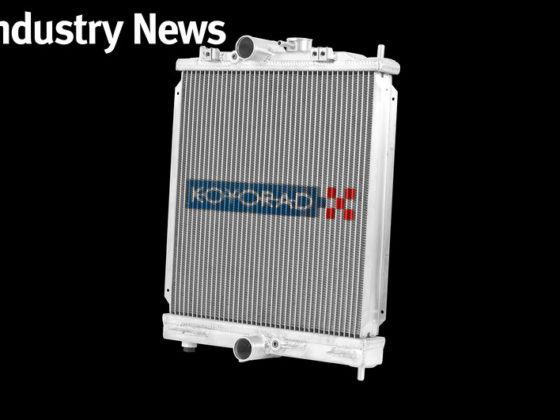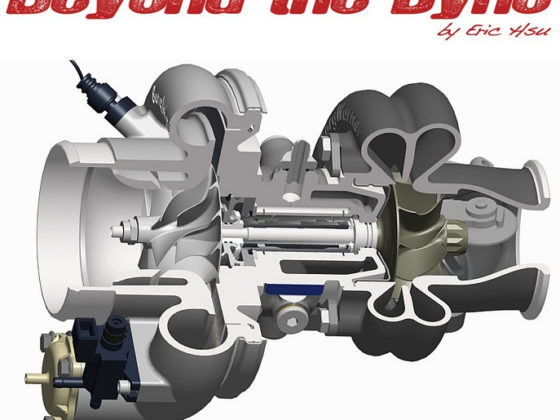,
An important advantage of Stoptech calipers is that the proportioning of their systems is carefully calculated to match the Spec-V’s hydraulic system. On stock single master cylinder brake hydraulic systems, the brake’s proportioning is mostly determined by the caliper piston size. The larger the piston the greater the hydraulic force applied to the brake pad, the smaller, the less. Stoptech duplicates the OEM proportioning using 19 different possible combinations of piston sizes. Stoptech has the greatest spread of piston sizes available on the market and thus can come the closest towards duplicating the correct proportioning when compared to other manufacturers.
 |
| 13″ Stoptech Aerorotors have alloy hats so they end up being lighter despite being much bigger and thicker than stock. |
Many things are considered when choosing piston sizes; stock master cylinder bore diameter, car size and weight, weight distribution, brake pad size, rotor size, tire size and wheel size. Another important aspect to the piston sizing is using different sized pistons on the leading and trailing sides of the brake pad to eliminate taper wear (where the leading and trailing sides of the pads wear at different rates). Taper wear is caused by the leading edge of the pad digging in and causing a tipping moment that increases pressure and wear on the front side of the pad.
Another major advantage of the ST-40 caliper over stock is the size of brake pad used; the ST-40 uses a common Porsche size (back plate outline D609) which is significantly larger than the stock pad and comes in just about every pad compound known to man. With bigger pads you can do more braking before they are used up. Also, they have more thermal mass. For equal energy/heat input into the pads, the larger pads have less temperature increase.
 |
| You can see the staggered vanes on the Aerorotors here as well as the vanes on the aero hats. These help keep things cool and in the case of the hat, reduce heat transfer. |
We replaced the stock Nissan front rotors with Stop Tech AeroRotors. The StopTech 2-piece rotor are 328mm diameter, 28mm thick, and uses StopTech’s patented AeroRotor vane design. There are a few advantages associated with the increased rotor size.
The larger diameter and the added thickness in the brake pad contact area means there’s a lot more mass. This is one place on a car where you want more mass as it means there’s more thermal capacity. Another key feature of the StopTech AeroRotor are their directional vanes. The directional vanes induce greater cooling air flow (as compared to the stock straight vanes) through the rotor which reduces its operating temperature. Directional vanes tend to interrupt the propagation of radial cracks, making for an inherently more durable part than the stock, straight-vane rotors.




4 comments
Hey guys. This build seems to be highly… outsourced. Like, HotRod PowerTV outsourced. I don’t mind that you spend some money to get these things done, or talk with experts who are highly paid when they get some things done, but some research and reporting on your decision-making might help make it look less sponsored and may help out people with a smaller budget.
In the case of B15 brakes, admittedly the single piston calipers are the WORST, as are the crappy quality rotors. Did you put any consideration into the ’04+ B15 Brembo front setup with some decent pads? What, ultimately, pushed you toward the StopTech kit? Were any other kits commercially available? Were there any kits that would address the garbage stock rear calipers with poorly-chromed pistons?
Also, possibly helpful would be published dates on your articles. I’m not sure if I’m responding to an article from 10 years ago or not here…
This is a race car, not a cheap car. We don’t care if it “looks sponsored”. Stoptech calipers are the best for stock hydraulic systems bar none due to their wide range of piston sizes. I am not sure what you are talking about when you say outsourced, there are a lot of in-house designed and fabricated parts in this car.
You sound a little defensive. I guess I’ll have to explain better?
If you watch HotRod PowerTV, it becomes pretty obvious that they aren’t actually informative shows so much as they’re paid plugs for the products showcased in each episode. In this way, the work is both sponsored, and outsourced. Bolt-ons, if you will. This isn’t to say I’m against bolt-on modifications, especially with something so critical as a braking system, but knowing more of your thought processes would be nice.
If you had a decision making process, perhaps laying it out in the article would help people reading understand what’s going on. You say “Stoptech calipers are the best for stock hydraulic systems bar none due to their wide range of piston sizes.” and two things immediately come to appear. You’ve stated one objective fact that supports your opinion (their wide range of piston sizes), and one outrageous opinion that does nothing to support your decision (best, hands-down).
If Stoptech sponsored, use journalistic integrity and disclose it. If you didn’t, and want to expand further on how you arrived at using their calipers, feel free to do so (heck, “They’re the only ones who make a kit” is even an okay answer). Do it in the article, even. The fact that you’ve “decided” in the TECH article without explaining the decision-making process doesn’t help your readers learn from the article. A good nugget here would have been a primer on brake balance and bias, and the importance of maintaining a relatively stock f/r area ratio… I appreciate your criticism of the stock, lo-perf, 1-piston calipers. They’re junk. They need to be replaced for a safe, functional car.
I’ll also reiterate: Did you consider the ’04+ Brembo systems? Should there be something I’m concerned with when *I* choose to go with the factory Brembo setup? Problems with track-day heat rejection, etc?
Did you research any systems that replaced the REALLLY BAAAD rear calipers with anything more reliable? Hell, if you’re plugging Stoptech, and they have a replacement, tell me THAT, even.
Not defensive, but I am annoyed at the journalistic integrity shots. I am pretty sure people are not interested in the extreme details of my decision-making process in this type of article, a primer on brake balance and bias is a huge digression from an article about building a car, it’s a whole new article. For an idea on how Stoptech does validation to determine proportioning read this. This too. Stoptech has 32 different piston sizes and since I didn’t want to go to a pedal box and balance bar, this is the best way to put a front brake with a significantly larger than factory Brembo front rotor and pad volume in while still maintaining proper proportioning. There is nothing outrageous about this and it’s not an opinion, its a fact. I also wanted to have a floating front rotor to reduce piston knockback and a lighter 2-piece rotor, not available with the factory Brembo stuff. I have been competing in road racing with the Sentra platform for years and the factory rear brakes are completely adequate and reliable. A FWD race car doesn’t use much rear brake and for instance, the rear pads can easily last for a couple of seasons. In my opinion, the only reason to change to a two piston race caliper on these cars would be for less weight and the abilty to choose from a wider assortment of brake pads. Or to have a more reasonable rear master cylinder size so the balance bar can be staged straighter if using a pedal box, dual master cylinders, and a balance bar. Oem single piston rear brakes can be used on pretty extreme FWD race cars. The record-breaking Spoon Civic and the all-dominating PZ Tuning Civic both use stock rear brakes.